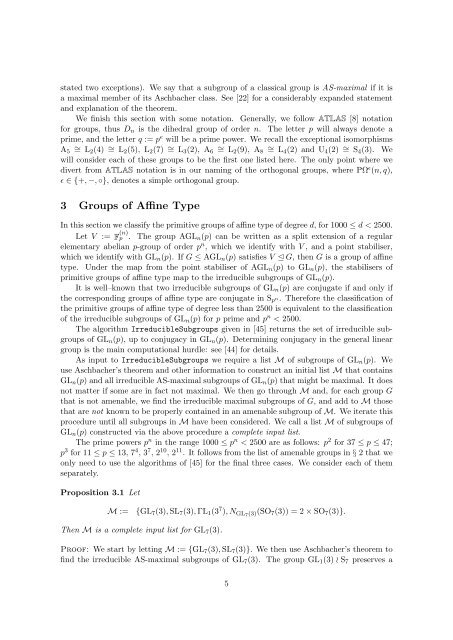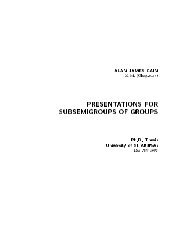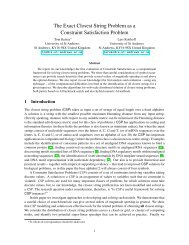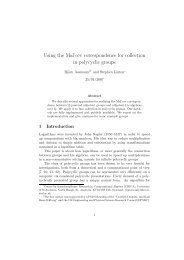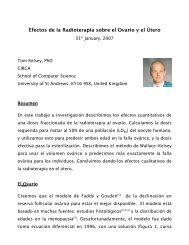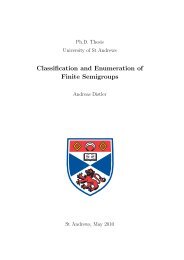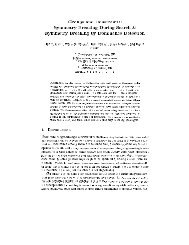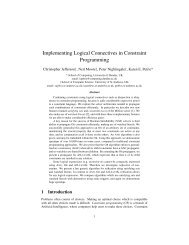The primitive permutation groups of degree less than 2500
The primitive permutation groups of degree less than 2500
The primitive permutation groups of degree less than 2500
Create successful ePaper yourself
Turn your PDF publications into a flip-book with our unique Google optimized e-Paper software.
stated two exceptions). We say that a subgroup <strong>of</strong> a classical group is AS-maximal if it isa maximal member <strong>of</strong> its Aschbacher class. See [22] for a considerably expanded statementand explanation <strong>of</strong> the theorem.We finish this section with some notation. Generally, we follow ATLAS [8] notationfor <strong>groups</strong>, thus D n is the dihedral group <strong>of</strong> order n. <strong>The</strong> letter p will always denote aprime, and the letter q := p e will be a prime power. We recall the exceptional isomorphismsA 5∼ = L2 (4) ∼ = L 2 (5), L 2 (7) ∼ = L 3 (2), A 6∼ = L2 (9), A 8∼ = L4 (2) and U 4 (2) ∼ = S 4 (3). Wewill consider each <strong>of</strong> these <strong>groups</strong> to be the first one listed here. <strong>The</strong> only point where wedivert from ATLAS notation is in our naming <strong>of</strong> the orthogonal <strong>groups</strong>, where PΩ ɛ (n, q),ɛ ∈ {+, −, ◦}, denotes a simple orthogonal group.3 Groups <strong>of</strong> Affine TypeIn this section we classify the <strong>primitive</strong> <strong>groups</strong> <strong>of</strong> affine type <strong>of</strong> <strong>degree</strong> d, for 1000 ≤ d < <strong>2500</strong>.Let V := F (n)p . <strong>The</strong> group AGL n (p) can be written as a split extension <strong>of</strong> a regularelementary abelian p-group <strong>of</strong> order p n , which we identify with V , and a point stabiliser,which we identify with GL n (p). If G ≤ AGL n (p) satisfies V ✂ G, then G is a group <strong>of</strong> affinetype. Under the map from the point stabiliser <strong>of</strong> AGL n (p) to GL n (p), the stabilisers <strong>of</strong><strong>primitive</strong> <strong>groups</strong> <strong>of</strong> affine type map to the irreducible sub<strong>groups</strong> <strong>of</strong> GL n (p).It is well–known that two irreducible sub<strong>groups</strong> <strong>of</strong> GL n (p) are conjugate if and only ifthe corresponding <strong>groups</strong> <strong>of</strong> affine type are conjugate in S p n. <strong>The</strong>refore the classification <strong>of</strong>the <strong>primitive</strong> <strong>groups</strong> <strong>of</strong> affine type <strong>of</strong> <strong>degree</strong> <strong>less</strong> <strong>than</strong> <strong>2500</strong> is equivalent to the classification<strong>of</strong> the irreducible sub<strong>groups</strong> <strong>of</strong> GL n (p) for p prime and p n < <strong>2500</strong>.<strong>The</strong> algorithm IrreducibleSub<strong>groups</strong> given in [45] returns the set <strong>of</strong> irreducible sub<strong>groups</strong><strong>of</strong> GL n (p), up to conjugacy in GL n (p). Determining conjugacy in the general lineargroup is the main computational hurdle: see [44] for details.As input to IrreducibleSub<strong>groups</strong> we require a list M <strong>of</strong> sub<strong>groups</strong> <strong>of</strong> GL n (p). Weuse Aschbacher’s theorem and other information to construct an initial list M that containsGL n (p) and all irreducible AS-maximal sub<strong>groups</strong> <strong>of</strong> GL n (p) that might be maximal. It doesnot matter if some are in fact not maximal. We then go through M and, for each group Gthat is not amenable, we find the irreducible maximal sub<strong>groups</strong> <strong>of</strong> G, and add to M thosethat are not known to be properly contained in an amenable subgroup <strong>of</strong> M. We iterate thisprocedure until all sub<strong>groups</strong> in M have been considered. We call a list M <strong>of</strong> sub<strong>groups</strong> <strong>of</strong>GL n (p) constructed via the above procedure a complete input list.<strong>The</strong> prime powers p n in the range 1000 ≤ p n < <strong>2500</strong> are as follows: p 2 for 37 ≤ p ≤ 47;p 3 for 11 ≤ p ≤ 13, 7 4 , 3 7 , 2 10 , 2 11 . It follows from the list <strong>of</strong> amenable <strong>groups</strong> in § 2 that weonly need to use the algorithms <strong>of</strong> [45] for the final three cases. We consider each <strong>of</strong> themseparately.Proposition 3.1 LetM := {GL 7 (3), SL 7 (3), ΓL 1 (3 7 ), N GL7 (3)(SO 7 (3)) = 2 × SO 7 (3)}.<strong>The</strong>n M is a complete input list for GL 7 (3).Pro<strong>of</strong>: We start by letting M := {GL 7 (3), SL 7 (3)}. We then use Aschbacher’s theorem t<strong>of</strong>ind the irreducible AS-maximal sub<strong>groups</strong> <strong>of</strong> GL 7 (3). <strong>The</strong> group GL 1 (3) ≀ S 7 preserves a5


